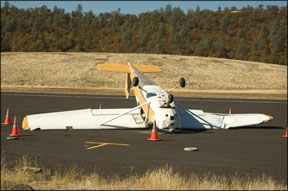Anyone whos spent much time flying personal aircraft has been asked this question: Is it safe? As a rule, the answer is, “It depends.” Because safety is relative, sitting at home can be the safest course of action. But its usually not very rewarding, and sitting at home makes it much more difficult to travel in a personal aircraft. 288 Beginning on page 24 of this issue, we look at a recent accident the NTSB attributed to low-level maneuvering. In critiquing that accident, we referred to the AOPA Air Safety Foundation (AOPA/ASF) and its most recent Nall Report, an annual in-depth look at GA accident trends. The data in those annual reports is very intriguing; so much so, we thought wed examine some of it more closely. We wanted to pose the question, “Is it safe to do X?” when X is some operation, maneuver or decision made by a GA pilot. While every operation and skill level is different, what we really wanted to do is highlight some of the areas in which GA pilots routinely bend metal, with the idea of using the 2007 Nall Report, the most recent available, and its findings to demonstrate why doing what youre about to do might not be a good idea. Pilot-Related The AOPA/ASF breaks down major causes for GA accidents into three broad categories: Pilot-related, mechanical/maintenance or other/unknown (includes pilot incapacitation and accidents for which a cause could not be determined). The 2006 numbers are summarized in Figure 1, on the opposite page. Even a cursory glance will demonstrate the overwhelming majority of accidents stem from pilot-related causes. This is a good/bad news situation: Our record as pilots isnt good, but at least its something over which we have some control. Another piece of good news, according to AOPA/ASF, is pilot-related accidents “represented a smaller proportion of overall accidents in 2006” when compared to 2005. Another way to put it: As long as we pay attention to maintenance issues, the airplane isnt likely to let us down. The same cant be said for the nut behind the wheel (or yoke). Figure 2, also on the opposite page, breaks down the pilot-related accident causes into separate categories. Some easy conclusions can be drawn from this data: The first thing jumping out at us is we cant land: The largest percentage of all accidents occurred when we tried. Fortunately, few of our landing accidents in 2006 proved fatal. But the question is why cant we land? After all, every flight up to the accident ended with a landing. Why cant we get this right consistently? Likewise, takeoffs and climbs: The next highest incidence of accidents occurred when trying to take off. In some ways, a takeoff accident is more understandable than when landing. After all, the takeoff is the first chance we have to ensure everythings working as it should. The other big thing about takeoffs, of course, is were accelerating at full power. Thats a sharp contrast to landings, when were decelerating at reduced power. Still, as much practice as we get at takeoffs and landings, we shouldnt be bending airplanes during these flight phases. In the article beginning in page 24, we talk extensively about maneuvering flight and a specific fatal accident attributed to it. For our purposes here, however, note maneuvering accidents comprise less than 10 percent of the total but result in fatalities 25 percent of the time. Fuel management also figures prominently, which were forced to put in the additional category of “dumb pilot tricks”: From Day One of pilot training, were told aircraft dont fly well or far without fuel. While some of these accidents may result from mismanagement-theres fuel aboard, but the pilot cant get it to the engine(s)-fuel starvation is another phrase describing a pilot who doesnt know his or her aircraft systems. An evening spent reviewing the aircrafts paperwork should remedy this. Descents and approaches comes in next. Although the AOPA/ASF data isnt detailed enough to break down this category, wed guess controlled flight into terrain (CFIT) at night and in poor weather, and busting instrument approach minimums figure prominently in these kinds of accidents. Both are preventable by ensuring situational awareness; modern cockpit gadgets can help, also. Weather is always a factor in aviation accidents, but were actually a bit surprised accidents attributed to it arent more prevalent. For us, the takeaway is that fatalities resulting from weather-related accidents is the third-highest percentage of causes identified by AOPA/ASF, behind only maneuvering and the descent/approach categories. What To Do About It While remaining accident categories-especially go-arounds; see page 4 of this issue-are just as important as the foregoing, those discussed above are far more prevalent and preventable, in our view. For example, we need to learn how to land and take off consistently. One way to do this is, well, to do it. Practice, at first with an instructor to identify any bad habits, and then in mild crosswinds, at unfamiliar airports and at short/soft fields. Meanwhile, ensure you have fuel adequate to the planned flight. You do look in the tanks before each takeoff, right? You do follow the manufacturers recommendations for leaning, and plan to be on the ground well before exhausting the supply, right? Dumb stunts like low flying and maneuvering in aircraft not designed for it, and for which we have no training, claim way too many pilots and aircraft. Just dont do it. Poor weather is like corrupt politics: Well always have it. Avoiding the weather, though, is lots easier than the politics, If we followed these basic recommendations, wed overnight reduce the total number of accidents by around 70 percent, and fatals would drop by a similar percentage. Why cant we do that? When someone asks, “Is GA safe?” the appropriate response is, “Its as safe as we want it to be.”




